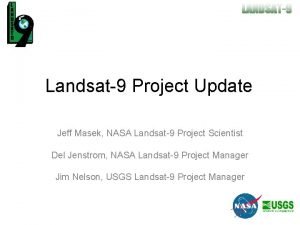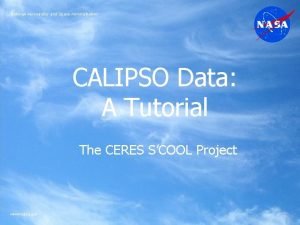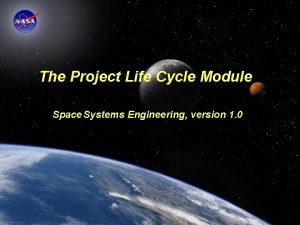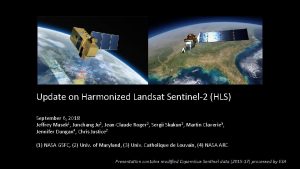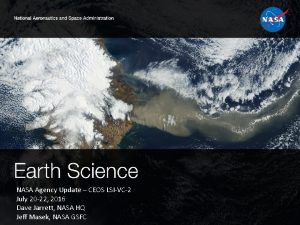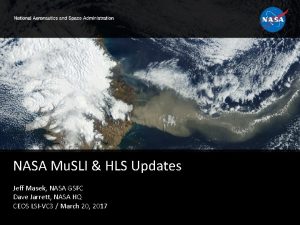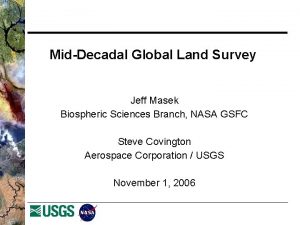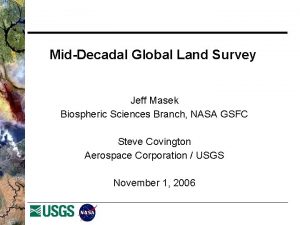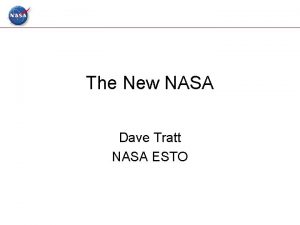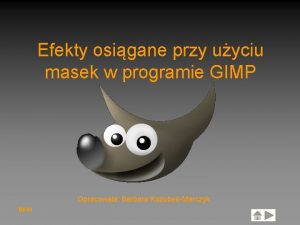Landsat9 Project Update Jeff Masek NASA Landsat9 Project









- Slides: 9

Landsat-9 Project Update Jeff Masek, NASA Landsat-9 Project Scientist Del Jenstrom, NASA Landsat-9 Project Manager Jim Nelson, USGS Landsat-9 Project Manager

L 9 Roles, Responsibilities • NASA responsible for the Space Segment, Launch, and On-orbit checkout • USGS responsible for the Ground System (including MOC) and Mission Operations – NASA developed MOC with USGS funding for Landsat 8; USGS now assumes that responsibility

L 9 Project Organization Project Science Office Project Scientist – Jeff Masek Deputy Proj. Sci. – Bruce Cook Instrument Scientist – Phil Dabney TIRS Instrument Scientist – Dennis Reuter Financial Mgmt. Project Manager – Del Jenstrom Deputy Project Manager – Steve Pszcolka DPM/Resources – Lorrie Eakin Admin Asst. – Pam Carrick Proj. Support Mgmt. Kelly Catlett Procurement Manager – Karen Place Contracting Officer – Patty Dombrowski NASA HQ Program Exec – David Jarrett KSC – USGS Landsat Project Mgr – Jim Nelson Chief S&MA Officer – Jim Lohr Mission System Engineering Evan Webb - Systems Manager & TA USGS Representative(s) USGS Chief Eng. – USGS Sys. Eng. – Jason Williams Communications Obs Mgr Vicki Dulski Cal/Val Mgr Brian Markham OLI Inst. Mgr Matt Strube TIRS Inst. PM Jason Hair/490 LV I/F Mgr Mission Ops Readiness Mgr Ground System Mgr USGS GS Mgr – Brian Sauer USGS GS Int. Lead – Doug USGS FSM – Joe Cavaluzzi Daniels USGS FOT

USGS L 9 Organization

What to Expect from Landsat-9 • Identical requirements as Landsat-8 – Building to L 8 requirements, not L 8 performance • In most cases L 8 performance will be achieved due to reuse of L 8 designs, or through engineering margins • OLI-2 will be an exact clone of L 8 OLI – L 8 hardware (spare FPM’s, mirrors, etc. ) to be reused – Expect OLI-2 performance to be comparable to L 8 OLI • TIRS upgraded to Class B (5 year design life) – Fix L 8 scattered radiance issue • Tested flight spare lens assembly with 10 micron laser; confirmed source of stray light as side of lens assembly above Lens 3 • Solution involves making area non-reflective (e. g. ridged insert or aperture stop) – Fix encoder electronics issue • Likely that problem due to filament growth & shorting • Manufacturing issue that requires improved monitoring & QA for TIRS-2 • L 8 Side B encoder electronics show no degradation so far – Improve reliability to 5 -year design life

Potential L 9 Relaxations (for LST Input) • High-priority acquisitions – SMRD - 75 The LDCM observatory shall be capable of collecting up to 5 priority scenes per day. • Off-nadir acquisitions – SMRD - 77 The LDCM observatory shall be capable of collecting image data up to 15 degrees left or right of the orbit plane in lieu of the nadir WRS-2 path as requested. – SMRD - 79 The LDCM observatory shall be capable of collecting up to 2 off-nadir intervals per day. • Both impact spacecraft design (agility, SSR software) and cost • Neither capability is widely used for Landsat 8 – Original rationale was emergency response & homeland security • Many more assets in orbit now to provide rapid response – Lack of use partly due to USGS policy to avoid off-nadir collects in order to maximize global imaging – Some benefit (? ) of off-nadir looks for coastal/reefs (avoiding sun glint) and polar acquisitions

Landsat 9 Data Coverage • L 9 maintains Level-1 requirement for 400 scenes/day – Landsat-8 currently achieves ~725 scenes/day by leveraging margin in SSR & downlink availability – Anticipate similar margins for Landsat 9 spacecraft, and thus similar acquisition levels – USGS planning for appropriate ground station contact time as well as data processing and storage to handle additional data collections • Potential 14 -bit resolution for OLI-2 data – OLI (and OLI-2) data is collected at 14 -bit resolution – L 8 spacecraft truncates to 12 -bit – Consideration for collecting L 9 OLI-2 at full 14 -bit resolution • Need to understand science application advantages

Looking to the Future (1/2) • SLI Reduced-Envelope Study examined opportunities for smaller, less expensive VSWIR-TIR instruments – Six companies funded to develop design concepts – See January LST presentation for recap • Developing follow-on studies on science impact of compact instrumentation – Use World. View imagery to simulate RER recovery via oversampling and sharpening algorithms – DIRSIG simulation of non-telecentric FP designs and science impact of spectral, radiometric non-uniformity – Sensitivity of coastal water & vegetation biophysical retrievals to polarization • Looking for volunteers to help assess science impact

Looking to the Future (2/2) • Current SLI suggests Landsat 10 launch ~2030 • Next 5 -6 years provide a window for evaluating options – Community science & application needs • Continuity • New observations (additional spectral bands, hyperspectral, etc) – Ability to merge int’l systems for improved temporal resolution – Technology and engineering considerations • Smaller instrumentation -> lower costs, higher cadence • Additional capabilities (e. g. more spectral resolution/coverage) • Land community should not be shy about expressing priorities for the next phase of SLI
